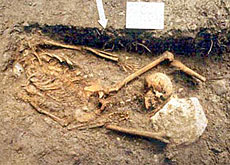Excavations bring Bern’s past to life

Swiss excavation specialists have uncovered an 18th century graveyard during construction work on a new building for the Swiss parliament.
They hope the find – the second of its kind – will shed light on life in Bern 300 years ago.
Archaeologists stumbled across around 270 human skeletons, thought to be people of high social standing, during excavations near the parliament building last November.
Earlier in the year a paupers’ graveyard was discovered at another site in the Swiss capital.
“We are hoping to gather information on the social and economic history of the period between 1730 and 1820 when this graveyard was still in use,” excavation specialist Martin Portmann told swissinfo.
Researchers at Bern University’s historic anthropology department are currently examining skeletons from both sites.
Bent spines
They say one of the most interesting findings is that nine of the skeletons from the “upper-class” burial ground bear signs of scoliosis, a curvature of the spine.
“The bent spine comes from polio, an illness that was quite prominent at that time,” Domenic Rüttimann of the historic anthropology department told swissinfo.
But what puzzles the anthropologists is that none of the skeletons in the pauper’s graveyard show signs of the disease.
“We haven’t found any bent spines on the skeletons of the poor people, and we hope we’ll be able to solve this puzzle in the coming years, when we get a closer look at all the skeletons,” Rüttimann said.
Pauper’s grave
The graveyard of the upper-class people, the so-called Burghers of Bern, dates back to the time between 1730 and 1820 – the same period the pauper’s cemetery was in use.
“It’s going to be interesting to discover the differences in burial habits between the two graveyards, and the variation in diseases the two social groups suffered from,” Portmann said.
The anthropologists’ work is made easier if they are on site during the excavations, Rüttimann says.
“Being there gives us an impression of the population and of how the cemetery might have looked. It’s very important for us to have this connection to the skeletons, as they are still individuals for us,” he said.
“Otherwise we would just have bones with numbers in the laboratory and the whole thing would not be alive.”
The excavations are due to end in April, after which the real work will begin.
“There are still many unanswered questions, but I hope we will be able to answer them in the next few years and then maybe even write a book about it,” Rüttimann said.
swissinfo, Billi Bierling
In November 2003 a cemetery for upper class people was discovered near the Swiss parliament building in Bern.
Around 270 skeletons were found in the graveyard that was in use between 1730 and 1820.
During excavations in 2002, a paupers’ cemetery dating from the same period was found near Bern university.
Anthropologists hope to discover some of the differences between the poor and rich societies in Bern during the period 1730-1820.

In compliance with the JTI standards
More: SWI swissinfo.ch certified by the Journalism Trust Initiative

You can find an overview of ongoing debates with our journalists here. Please join us!
If you want to start a conversation about a topic raised in this article or want to report factual errors, email us at english@swissinfo.ch.